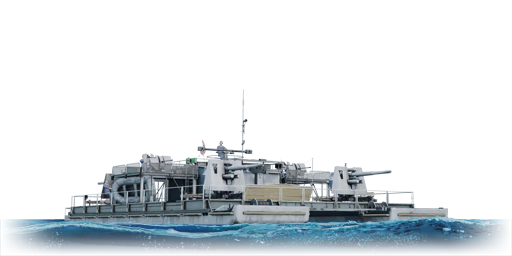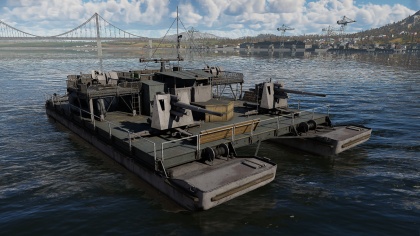Difference between revisions of "SF40 Heavy"
Inceptor57 (talk | contribs) (Added history and devblog link) |
Inceptor57 (talk | contribs) (Added devblog link and history, Removed nonrelevant armament sections) |
||
| Line 26: | Line 26: | ||
''If there is no secondary armament, remove this section.'' | ''If there is no secondary armament, remove this section.'' | ||
| − | |||
| − | |||
| − | |||
| − | |||
| − | |||
| − | |||
| − | |||
| − | |||
| − | |||
| − | |||
| − | |||
| − | |||
| − | |||
== Usage in battles == | == Usage in battles == | ||
| Line 61: | Line 48: | ||
However, before all 400 vessels could be made, the Invasion of Britain was cancelled and thus the need for the Siebelfähre also disappeared below the waves. Nonetheless, around 200 of these vessels were still made before the order was cancelled and a majority of them found use in transport and mine-laying operations in the Black Sea and the Mediterranean. The Siebelfähre saw use right up to the end of the war and some vessels continued serving well into the 1960s as civilian ferries. | However, before all 400 vessels could be made, the Invasion of Britain was cancelled and thus the need for the Siebelfähre also disappeared below the waves. Nonetheless, around 200 of these vessels were still made before the order was cancelled and a majority of them found use in transport and mine-laying operations in the Black Sea and the Mediterranean. The Siebelfähre saw use right up to the end of the war and some vessels continued serving well into the 1960s as civilian ferries. | ||
| + | |||
| + | ''- From [https://warthunder.com/en/news/5589-fleet-development-siebelf%C3%A4hre-sf-40-schwere-en Devblog]'' | ||
== Media == | == Media == | ||
Revision as of 05:29, 9 March 2019
Contents
Description
The Siebelfähre 40 Heavy is a Rank III German anti-air ferry
with a battle rating of 2.7 (AB/RB/SB). It was introduced in Update 1.79 "Project X" in the fleet closed beta test.
General info
Survivability and armour
Talk about the vehicle’s armor. Note the most well-defended and most vulnerable zones, e.g. the ammo magazine. Evaluate the composition of components and assemblies responsible for movement and maneuverability. Evaluate the survivability of the primary and secondary armament separately. Don't forget to mention the size of the crew, which plays an important role in fleet mechanics. Tips for preserving survivability should be saved for the “Use in battle” section.
If necessary, use a graphic template to show the most well-protected or most vulnerable points in the armor.
Mobility
Write about the ship’s mobility. Evaluate its power and maneuverability, rudder rerouting speed, stopping speed at full tilt, with its maximum forward speed and reverse speed.
Armament
Primary armament
Provide information about the characteristics of the primary armament. Evaluate their efficacy in battle based on their reload speed, ballistics and the capacity of their shells. Add a link to the main article about the weapon: {{main|Weapon name}}.
Broadly describe the ammunition available for the primary armament, and provide recommendations on how to use it and which ammunition to choose.
Secondary armament
Some ships are fitted with weapons of various calibers. Secondary armament is defined by the weapon chosen with the control Select secondary weapon. Evaluate the secondary armament and give advice on how to use them. Describe the ammunition available for the secondary armament. Provide recommendations on how to use them and which ammunition to choose. Remember that anti-air armament, even heavy caliber weapons, belong in the next section.
If there is no secondary armament, remove this section.
Usage in battles
Describe the technique of using this ship, the characteristics of her use in a team and tips on strategy. Abstain from writing an entire guide – don’t get try to provide a single point of view, but give the reader food for thought. Talk about the most dangerous opponents for this vehicle and provide recommendations on fighting them. If necessary, note the specifics of playing with this vehicle in various modes (AB, RB, SB).
Pros and cons
Summarize and briefly evaluate the vehicle in terms of its characteristics and combat effectiveness. Mark its pros and cons in the bulleted list. Try not to use more than 6 points for each of the characteristics. Avoid using categorical definitions such as "bad", "good" and the like - they have a substitution in the form of softer "inadequate", "effective".
Pros:
Cons:
History
The Siebelfähre was designed by Friedrich Siebel, owner of a lesser known German aircraft manufacturing company bearing his name. Siebel’s idea was to provide the German army with a much needed easily mass-produced and effective transport vessel for the planned invasion of Britain.
His ferry would be a construction utilising parts of bailey bridges and pontoons, which would make up the two barges connected with each other in a catamaran style by a wooden deck. The vessel was supposed to be powered by aircraft engines and could easily be disassembled and reassembled thanks to its modular construction, allowing for the vessel to also be transported by land.
The idea was met with great enthusiasm from the German military and an order for 400 of these ferrycraft soon followed. The order encompassed more than just one version of the vessel, however. For instance, some versions were specialised to perform anti-air duties and were meant to cover the landing troops from air attacks. These were equipped with light 20mm and 37mm AA guns up to the heavy FlaK 88mm cannon, depending on the version.
However, before all 400 vessels could be made, the Invasion of Britain was cancelled and thus the need for the Siebelfähre also disappeared below the waves. Nonetheless, around 200 of these vessels were still made before the order was cancelled and a majority of them found use in transport and mine-laying operations in the Black Sea and the Mediterranean. The Siebelfähre saw use right up to the end of the war and some vessels continued serving well into the 1960s as civilian ferries.
- From Devblog
Media
An excellent addition to the article will be video guides, as well as screenshots from the game and photos.
See also
Links to the articles on the War Thunder Wiki that you think will be useful for the reader, for example:
- reference to the series of the ship;
- links to approximate analogues of other nations and research trees.
External links
| Germany barges | |
|---|---|
| Anti-air ferries | SF40 Light · SF40 Heavy |
| Naval ferry barges | AF D1 · AF D3 |





